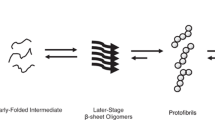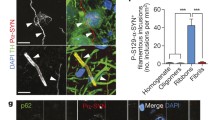Abstract
The 140-amino-acid protein α-synuclein (α-syn) is the major constituent of Lewy bodies. The protein interacts with several intracellular signal transduction pathways. Reasons for onset of abnormal aggregation of α-syn are unclear. Metal ions, oxidative stress, and β-amyloid 1–42 (Aβ1–42) are important induction factors for α-syn aggregation. β-Synuclein (β-syn) can counteract α-syn aggregation. Cross-breeding of β-syn transgenic mice with animals overexpressing α-syn significantly decreased α-syn-positive neuronal inclusion bodies and improved motor function. This was an important proof of concept for the role of β-syn in regulating α-syn aggregation. A drug discovery program based on peptide derivatives (N-terminal amino acids 1–15) of β-syn was initiated. For screening, tissue culture models simulating disease-specific conditions were utilized. They protected against growth factor withdrawal, Aβ toxicity, and oxidative stress. Three peptides were selected (KEGV, SMAKEGV, MDFMKGLSMAKE) for in vivo studies because they also decreased expression of Aβ1–40 and Aβ1–42. First, in vivo experiments were made in human amyloid precursor protein (APP [Swedish and London mutation]) transgenic mice, as well as α-syn transgenic mice. Treatment was performed with the peptides as an intraperitoneal injection or as intranasal droplets for 2 mo. Behavioral studies in APP transgenic mice were performed after 1 and 2 mo of treatment and showed clear effects of these peptides.
Similar content being viewed by others
References
Ahn B. H., Rhim H., Kim S. Y., Sung Y. M., Lee M. Y., Choi J. Y., et al. (2002) α-Synuclein interacts with phospholipase D isozymes and inhibits pervanadate-induced phospholipase D activation in human embryonic kidney-293 cells. J. Biol. Chem. 277, 12334–12342.
Biere A. L., Wood S. J., Wypych J., Steavenson S., Jiang Y. J., Anafi D., et al. (2000) Parkinson’s disease-associated α-synuclein is more fibrillogenic than β- and γ-synuclein and cannot cross-seed its homologs. J. Biol. Chem. 275, 34574–34579.
Conway K. A., Lee S. J., Rochet J. C., Ding T. T., Williamson R. E., and Lansbury P. T., Jr. (2000) Acceleration of oligomerization, not fibrillization, is a shared property of both alpha-synuclein mutations linked to early-onset Parkinson’s disease: implications for pathogenesis and therapy. Proc. Natl. Acad. Sci. U. S. A. 97, 571–576.
daCosta C. A., Paitel E., Vincent B., and Checler F. (2002) α-Synuclein lowers p53-dependent apoptotic response of neuronal cells—abolishment by 6-hydroxydopamine and implication for Parkinson’s disease. J. Biol. Chem. 277, 50980–50984.
Eliezer D., Kutluay E., Bussell R., and Browne G. (2001) Conformational properties of α-synuclein in its free and lipid-associated states. J. Mol. Biol. 307, 1061–1073.
Giasson B. I. and Lee V. M. (2001) Parkin and the molecular pathways of Parkinson’s disease. Neuron 31, 885–888.
Giasson B. I., Forman M. S., Higuchi M., Golbe L. I., Graves C. L., Kotzbauer P. T., et al. (2003) Initiation and synergistic fibrillization of tau and alpha-synuclein. Science 300, 636–640.
Goedert M. (2001) The significance of tau and α-synuclein inclusions in neurodegenerative diseases. Curr. Opin. Genet. Dev. 11, 343–351.
Gómez-Santos C., Ferrer I., Santidrián A. F., Barrachina M., Gil J., and Ambrosio S. (2003) Dopamine induces autophagic cell death and α-synuclein increase in human neuroblastoma SH-SY5Y cells. J. Neurosci. Res. 73, 341–350.
Hamilton R. L. (2000) Lewy bodies in Alzheimer’s disease: A neuropathological review of 145 cases using α-synuclein immunohistochemistry. Brain Pathol. 10, 378–384.
Hartbauer M., Hutter-Paier B., and Windisch M. (2001) Effects of Cerebrolysin on the outgrowth and protection of processes of cultured brain neurons. J. Neural Transm. 108, 581–592.
Hashimoto M., Hsu L. J., Rockenstein E., Takenouchi T., Mallory M., and Masliah E. (2002) α-Synuclein protects against oxidative stress via inactivation of the c-Jun N-terminal kinase stress-signaling pathway in neuronal cells. J. Biol. Chem. 277, 11465–11472.
Hashimoto M., Hsu L. J., Xia Y., Takeda A., Sisk A., Sundsmo M., and Masliah E. (1999) Oxidative stress induces amyloid-like aggregate formation of NACP/alpha-synuclein in vitro Neuroreport 10, 717–721.
Hashimoto M., Rockenstein E., Mante M., Mallory M., and Masliah E. (2001) β-Synuclein inhibits α-synuclein aggregation: a possible role as an anti-parkinsonian factor. Neuron 32, 213–223.
Iwai A., Masliah E., Yoshimoto M., Ge N., Flanagan L., de Silva H. A., Kittel A., and Saitoh T. (1995a) The precursor protein of non-A beta component of Alzheimer’s disease amyloid is a presynaptic protein of the central nervous system. Neuron 14, 467–475.
Iwai A., Yoshimoto M., Masliah E., and Saitoh T. (1995b) Non-A beta component of Alzheimer’s disease amyloid (NAC) is amyloidogenic. Biochemistry 34, 10139–10145.
Iwata A., Maruyama M., Kanazawa I., and Nukina N. (2001) Alpha-synuclein affects the MAPK pathway and accelerates cell death. J. Biol. Chem. 276, 45320–45329.
Jellinger K. A. (2003a) General aspects of neurodegeneration. J. Neural Transm. Suppl. 53, 101–144.
Jellinger K. A. (2003b) α-Synuclein pathology in Parkinson’s and Alzheimer’s disease brain: incidence and topographic distribution—a pilot study. Acta Neuropathol. 106, 191–201.
Kim K. S., Choi S. Y., Kwon H. Y., Won M. H., Kang T. C., and Kang J. H. (2002) The ceruloplasmin and hydrogen peroxide system induces α-synuclein aggregation in vitro. Biochimie 84, 625–631.
Krishnan S., Chi E. Y., Wood S. J., Kendrick B. S., Li C., Garzon-Rodriguez W., et al. (2003) Oxidative dimer formation is the critical rate-limiting step for Parkinson’s disease α-synuclein fibrillogenesis. Biochemistry 42, 829–837.
Lashuel H. A., Petre B. M., Wall J., Simon M., Nowak R. J., Walz T., and Lansbury P. T. (2002) α-Synuclein, especially the Parkinson’s disease-associated mutants, forms pore-like annular and tubular protofibrils. J. Mol. Biol. 322, 1089–1102.
Lee F. J. S., Liu F., Pristupa Z. B., and Niznik H. B. (2001) Direct binding and functional coupling of α-synuclein to the dopamine transporters accelerate dopamine-induced apoptosis. FASEB J. 15, 916–926.
Lippa C. F., Fujiwara H., Mann D. M., Giasson B., Baba M., Schmidt M. L., et al. (1998) Lewy bodies contain altered alpha-synuclein in brains of many familial Alzheimer’s disease patients with mutations in presenilin and amyloid precursor protein genes. Am. J. Pathol. 153, 1365–1370.
Lippa C. F., Schmidt M. L., Lee V. M., and Trojanowski J. Q. (1999) Antibodies to alpha-synuclein detect Lewy bodies in many Down’s syndrome brains with Alzheimer’s disease. Ann. Neurol. 45, 353–357.
Lippa C. F., Schmidt M. L., Lee V. M. Y., and Trojanowski J. Q. (2001) Alpha-Synuclein in familial Alzheimer disease—epitope mapping parallels dementia with Lewy bodies and Parkinson disease. Arch. Neurol. 58, 1817–1820.
Masliah E., Hansen L. A., Rockenstein E., and Hashimoto M. (2002) Progress in the development of new treatments for combined Alzheimer’s and Parkinson’s diseases. Drug Dev. Res. 56, 282–292.
Masliah E., Rockenstein E., Veinbergs I., Mallory M., Hashimoto M., Takeda A., et al. (2000) Dopaminergic loss and inclusion body formation in alpha-synuclein mice: implications for neurodegenerative disorders. Science 287, 1265–1269.
Masliah E., Rockenstein E., Veinbergs I., Sagara Y., Mallory M., Hashimoto M., and Mucke L. (2001) Beta-amyloid peptides enhance alpha-synuclein accumulation and neuronal deficits in a transgenic mouse model linking Alzheimer’s disease and Parkinson’s disease. Proc. Natl. Acad. Sci. U. S. A. 98, 12245–12250.
Mukaetova-Ladinska E. B., Hurt J., Jakes R., Xuereb J., Honer W. G., and Wischik C. M. (2000) α-Synuclein (α-Syn) (inclusions in Alzheimer and Lewy body diseases. J. Neuropathol. Exp. Neurol. 59, 408–417.
Muma N. A., Lee J. M., Gorman L., Heidenreich B. A., Mitrovic I., and Napier T. C. (2001) 6-Hydroxydopamine-induced lesions of dopaminergic neurons alter the function of postsynaptic cholinergic neurons without changing cytoskeletal proteins. Exp. Neurol. 168, 135–143.
Munishkina L. A., Phelan C., Uversky V. N., and Fink A. L. (2003) Conformational behavior and aggregation of α-synuclein in organic solvents: modeling the effects of membranes. Biochemistry 42, 2720–2730.
Nakamura T., Yamashita H., Takahashi T., and Nakamura S. (2001) Activated Fyn phosphorylates α-synuclein at tyrosine residue 125. Biochem. Biophys. Res. Commun. 280, 1085–1092.
Paik S. R., Lee D. Y., Cho H. J., Lee E. N., and Chang C. S. (2003) Oxidized glutathione stimulated the amyloid formation of α-synuclein. FEBS Lett. 537, 63–67.
Papapetropoulos S., Paschalis C., Athanassiadou A., Papadimitriou A., Ellul J., Polymeropoulos M. H., and Papapetropoulos T. (2001) Clinical phenotype in patients with α-synuclein Parkinson’s disease living in Greece in comparison with patients with sporadic Parkinson’s disease. J. Neurol. Neurosurg. Psychiatry 70, 662–665.
Park J. Y. and Lansbury P. T. (2003) β-Synuclein inhibits formation of α-synuclein protofibrils: a possible therapeutic strategy against Parkinson’s disease. Biochemistry 42, 3696–3700.
Parkkinen L., Soininen H., and Alafuzoff I. (2003) Regional distribution of α-synuclein pathology in unimpaired aging and Alzheimer disease. J. Neuropathol. Exp. Neurol. 62, 363–367.
Payton J. E., Perrin R. J., Clayton D. F., and George J. A. (2001) Protein-protein interactions of alpha-synuclein in brain homogenates and transfected cells. Mol. Brain Res. 95, 138–145.
Quilty M. C., Gai W. P., Pountney D. L., West A. K., and Vickers J. C. (2003) Localization of α-, β-, and γ-synuclein during neuronal development and alterations associated with the neuronal response to axonal trauma. Exp. Neurol. 182, 195–207.
Rockenstein E., Hansen L. A., Mallory M., Trojanowski J. Q., Galasko D., and Masliah E. (2001a) Altered expression of the synuclein family mRNA in Lewy body and Alzheimer’s disease. Brain Res. 914, 48–56.
Rockenstein E., Mallory M., Mante M., Sisk A., and Masliah E. (2001b) Early formation of mature amyloid-beta protein deposits in a mutant APP transgenic model depends on levels of Abeta(1-42). J. Neurosci. Res. 66, 573–582.
Seo J. H., Rah J. C., Choi S. H., Shin J. K., Min K., Kim H. S., et al. (2002) α-Synuclein regulates neuronal survival via Bcl-2 family expression and PI3/Akt kinase pathway. FASEB J. 16, 456–459.
Spira P. J., Sharpe D. M., Halliday G., Cavanagh J., and Nicholson G. A. (2001) Clinical and pathological features of a parkinsonian syndrome in a family with an Ala53Thr α-synuclein mutation. Ann. Neurol. 49, 313–319.
Takenouchi T., Hashimoto M., Hsu L. J., Mackowski B., Rockenstein E., Mallory M., and Masliah E. (2001) Reduced neuritic outgrowth and cell adhesion in neuronal cells transfected with human alpha-synuclein. Mol. Cell. Neurosci. 17, 141–150.
Thompson A. J. and Barrow C. J. (2002) Protein conformational misfolding and amyloid formation: Characteristics of a new class of disorders that include Alzheimer’s and prion diseases. Curr. Med. Chem. 9, 1751–1762.
Trembath Y., Rosenberg C., Ervin J. F., Schmechel D. E., Gaskell P., Pericak-Vance M., et al. (2003) Lewy body pathology is a frequent co-pathology in familial Alzheimer’s disease. Acta Neuropathol. 105, 484–488.
Trojanowski J. Q. (2002) Emerging Alzheimer’s disease therapies: focusing on the future. Neurobiol. Aging 23, 985–990.
Volles M. J. and Lansbury P. T. (2003) Zeroing in on the pathogenic form of α-synuclein and its mechanism of neurotoxicity in Parkinson’s disease. Biochemistry 42, 7871–7878.
Windisch M., Hutter-Paier B., and Schreiner E. (2002) Current drugs and future hopes in the treatment of Alzheimer’s disease. J. Neural Transm. Suppl. 53, 149–164.
Wolozin B. and Behl C. (2000) Mechanisms of neurodegenerative disorders. Part 1: protein aggregates. Arch. Neurol. 57, 793–796.
Yamin G., Glaser C. B., Uversky V. N., and Fink A. L. (2003) Certain metals trigger fibrillation of methionine-oxidized α-synuclein. J. Biol. Chem. 278, 27630–27635.
Zhu M. and Fink A. L. (2003) Lipid binding inhibits α-synuclein fibril formation. J. Biol. Chem. 278, 16873–16877.
Author information
Authors and Affiliations
Corresponding author
Rights and permissions
About this article
Cite this article
Windisch, M., Hutter-Paier, B., Schreiner, E. et al. β-synuclein-derived peptides with neuroprotective activity. J Mol Neurosci 24, 155–165 (2004). https://doi.org/10.1385/JMN:24:1:155
Issue Date:
DOI: https://doi.org/10.1385/JMN:24:1:155




